 |
| ‘..Rolls Royce
engines throbbing and growling into the thundering crescendo of a
stream take off will never fail to instil a feeling of wonder and
awe.’ |
The Imperial War Museum’s
Battle of Britain Airshow has become a welcome annual pilgrimage
for the reviewer, the event growing into Duxford’s premier warbird
offering in the absence of Flying Legends and its subsequent
successful move to the former RAF Church Fenton.
This
year’s show offered the full spectrum of historical military
aviation from Paul Ford’s Royal Aircraft Factory SE5a and Fokker
Dr1 Triplane replicas from the First World War era to a classic
post war jet in the shape of the Norwegian Historical Squadron’s
de Havilland Vampire FB.52, currently in the colours of the
Aeronautica Militare to commemorate the Italian Air Force’s 100th
year anniversary. |
 |
 |
| |
|
 |
 |
The meat of the sandwich,
however, was made up of Second World War warbirds. The show was
opened by a Battle of Britain set piece commemorating not only the
events of 1940, but the famous film of the same name that saw a
mini air force of Spitfires, ex-Spanish Air Force Hispano HA-1112
Buchons (license built Me109s powered by Rolls Royce Merlin
engines) and CASA 2.111 bombers (license built He111s also powered
by Merlins) descend on the UK for the summer of 1968 to film the
aerial sequences.
As readers will most probably know, this
contributed greatly to the warbird movement and it is indeed part
of the film’s ongoing legacy that two of its stars, Fighter
Aviation Engineering’s two seat ‘Red 11’ and the Aircraft
Restoration Company’s ‘Yellow 10’ flown by Dave Puleston and Steve
Jones respectively, displayed at the show, beating up Duxford’s
runway to the accompaniment of suitable pyrotechnics. In response,
two Spitfire MkIa scrambled, much as they would have done 83 years
ago, the Imperial War Museum’s own Spitfire N3200/G-MKIA ‘Duxford’
leading Comanche Fighter’s X4650/G-CGUK to fend off the marauding
Luftwaffe. |
 |
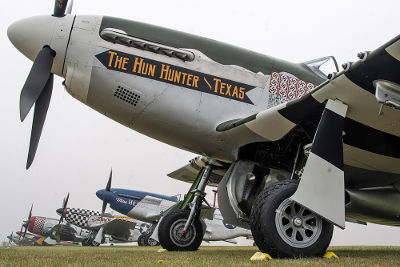 |
Following this
dramatic opening was one of the show’s most memorable moments. We
had already noticed the Battle of Britain Memorial Flight’s Avro
Lancaster B1 PA474 circling in the distance behind the museum and
Boeing B-17G Flying Fortress ‘Sally-B’ had taken off shortly after
the Buchons, and now we were treated to a sight not seen at an
airshow for 28 years.
Appearing through the haze was the
unmistakable silhouette of two of the Second World War’s most
famous heavy bombers in close line astern formation. Peter Kuypers
led in Sally-B, steering the bombers round for two passes, with
Flight Lieutenant Paul Wise at the controls of the BBMF’s
Lancaster. The second pass was with bomb bay doors open allowing
spectators to compare the Lancaster’s cavernous space with the
smaller bomb bay of the American machine. The pair of bombers then
split, with Sally-B returning to complete a welcome solo display
before PA474, now joined by BBMF Spitfire Mk LFIXe MK356, took
centre stage. |
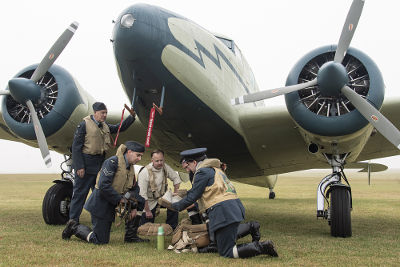 |
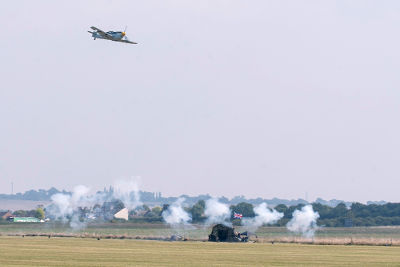 |
|
|
|
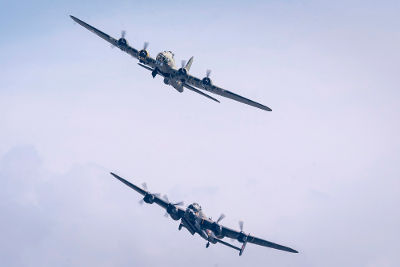 |
 |
As the
BBMF departed, the beginnings of what became a constant stream of
single engine warbirds took shape as the unmistakable outline of
three North American P-51D Mustangs could be seen taxiing out
along the crowdline towards the tank bank where they held for
power and magneto checks before taking off to hold. As World War
One biplanes cavorted overhead, the Mustangs were followed by a
pair of Spitfires and then three Hurricanes all positioning for
their own slots.
The P-51s entered their routine in a vic
formation led by Fighter Aviation Engineering Ltd’s TF-51D
‘Contrary Mary’ in the black and white checkerboard markings of
the Duxford based 78th Fighter Group, flanked by Robert Tyrrell’s
P-51D ‘Miss Helen,’ believed to be the last known original 352nd
Fighter Group P-51D in existence, and Comanche Fighters
ex-Guatemalan Air Force, 355th Fighter Group marked ‘The Hun
Hunter Texas,’ the Mustangs being flown by Mark Levy, John Dodd
and Pete Kynsey respectively. |
 |
 |
The next slot was taken by father and son team Brian and Nick
Smith in Spitfire IXs MH415 and MH434, Nick Smith having been
checked out in MH434 in July last year. Both Spitfires have aerial
victories to their name and a shared operational history with 222
(Natal) Squadron in whose markings they both fly today and it was
fitting to see both Spitfires and pilots linked in this way and
performing a graceful formation display.
Following the
Spitfires, arguably the poster boys of the Battle of Britain, came
the workhorses in the shape of a vic of three Hawker Hurricanes.
Two of these were provided by Hurricane Heritage with Mike Collett
leading in MkIIB BE505 ‘Pegs,’ the worlds’ only two seat
Hurricane, and James Brown in Battle of Britain veteran MkI R4118.
The third machine was Bygone Aviation’s MkI P3717 flown by Matt
Pettit. After a series of passes in formation, the Hurricanes
broke off into a more dynamic tail chase above The Fighter
Collection’s Curtiss P-36C and Hawk 75 that were holding on the
grass before performing their own close formation pairs display. |
 |
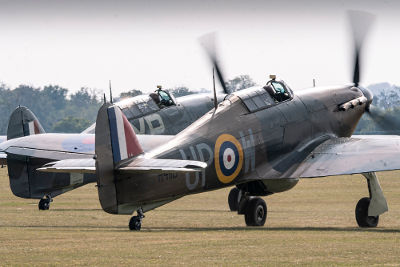 |
The pace slowed now as a series of more sedate warbirds took to
the air. These included the stunningly restored ex-Sidney Cotton
Lockheed 12A Electra Junior G-AFTL, Plane Sailings Consolidated
PBY-5A Catalina and Navy Wings’ Fairy Swordfish MkI W5856, now
cleared to carry a second crewmember for displays. The latter pair
commemorated types used in the Battle of the Atlantic. The
Swordfish was then joined by The Fighter Collection’s Hawker
Nimrod MkI, itself a navalised version of the Fury MkI fighter,
and the pair flew in formation before the Nimrod performed its own
energetic routine.
Another interesting formation followed
with The Shuttleworth Collection’s Avro C19 Anson and Gloster
Gladiator MkI joined by The Fighter Collection’s Gladiator MkII
for a flypast before both types displayed on their own, the
Gladiators being flown by Frank Chapman and Stu Goldspink.
|
 |
 |
| |
|
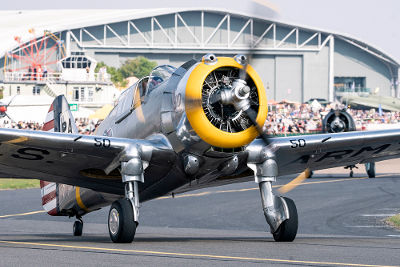 |
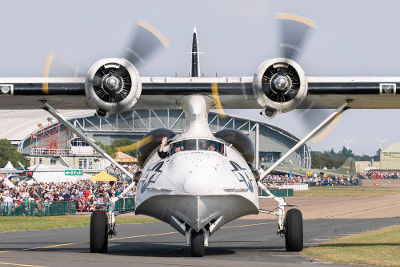 |
|
Next up came the UK’s two airworthy Westland
Lysander MkIIIs, the all-black Special Operations Executive
equipped V9367 from The Shuttleworth Collection contrasting well
with the camouflaged V9312 from the Aircraft Restoration Company.
Other differences that could be seen being the long range fuel
tank of V9367 used to aid the dropping of agents into occupied
Europe while V9312 had bomb racks on its wheel spats for its more
kinetic orientated role at the beginning of the war.
|
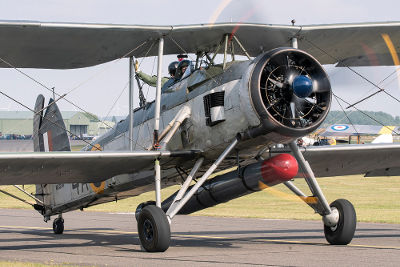 |
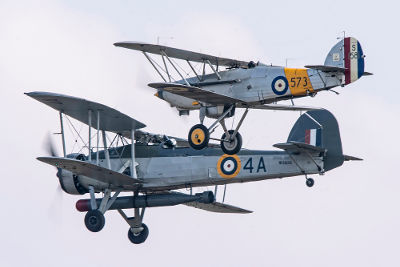 |
The first of the shows’ two
display teams then followed, this being in the shape of The Flying
Comrades and their radial engine powered Yak-18T and pair of
Yak-52s. Formed at the end of the lockdown in 2021, the team
consists of pilots Phil Hardisty, Alex Lewton and Tom Turner.
Yak-18T G-HAHU was built in 1993 although the design dates back to
the 1960s, the aircraft being used to train Aeroflot pilots. The
rugged Yak-52s, G-BXJB and G-YAKF, were built in Romania in 1987
and 1991 respectively and are based at Duxford.
The team’s
display was both refined and precise and offered an aperitif in
terms of the next display team to take the stage. However, there
was one final radial-powered interlude as Steve Jones took Fighter
Aviation Engineering’s mighty 2,000hp Bristol Centaurus powered
Hawker Fury FB11 G-CBEL aloft to showcase the ultimate expression
of Hawker’s piston engine fighter lineage. Rebuilt by Air Leasing
Ltd at Sywell, Manager and Chief Engineer Richard Grace recently
described the machine on the ‘We Have Ways of Making You Talk’
podcast as being his favourite warbird to fly. |
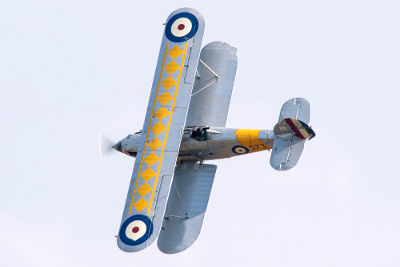 |
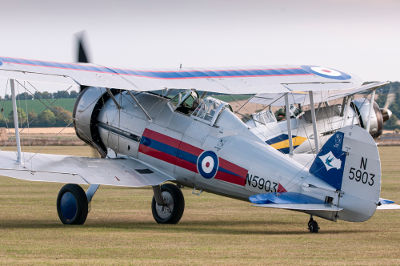 |
| |
|
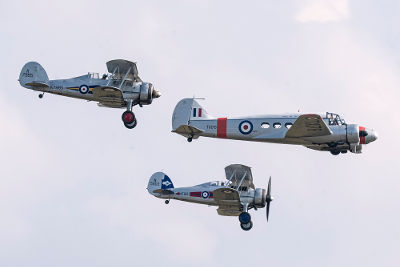 |
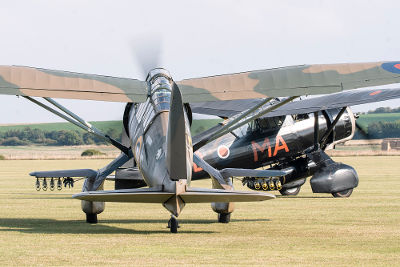 |
| With the Fury safely on the
ground, an airspace delay led to the show’s penultimate act, the
Red Arrows, being pushed back half an hour from their planned
4.30pm slot, although, to be honest, this gave the reviewer a
welcome chance to catch his breath after what had been three and a
half hours of constant, extremely well choreographed, non-stop
action. Red 10 duly took the microphone just before 5pm to
introduce this season’s 8-ship of Hawk T1As and what followed was
a typically polished routine. Particularly notable was the Tornado
manoeuvre which is normally carried out with red and blue smoke
for the rolling pair but which this time was completed with all
white smoke until the turn away from the crowd which, coupled with
the backlight conditions, made for a very photogenic sight. |
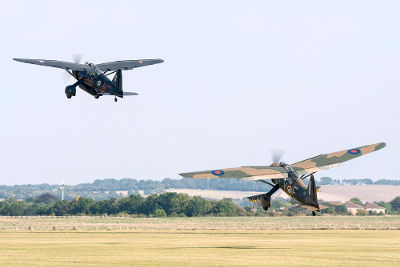 |
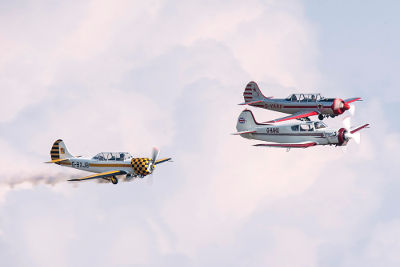 |
However, it is of course, the
Battle of Britain finale that sets this show apart and
anticipation was mounting as the capacity crowd’s applause for the
Red Arrows’ died away. The spectacle of a mass of Spitfires and
Hurricanes weaving along the taxiway to position on the grass in
ones, twos and threes, their powerful Rolls Royce engines
throbbing and growling into the thundering crescendo of a stream
take off will never fail to instil a feeling of wonder and awe.
As the last notes of the departing warbirds faded into the
distance, a new sound captivated, a snarling rasp that
reverberated across the airfield and preceded a flash of silver
and red that dived, rolled and looped effortlessly through the
arena of clouds. This was the ‘Jester,’ John Romain in the Aerial
Speed Icon’s Griffon powered Supermarine Spitfire MkXIV, the
evening sun dancing across its polished aluminium skin. The jester
entertained us and then retreated leaving the space wide and we
were transported back to 1940 and to 12 Group, Fighter Command’s
controversial ‘Big Wing.’ Led by the then Squadron Leader Douglas
Bader, and trumpeted by 12 Group’s Commanding Officer, Air Vice
Marshal Trafford Leigh-Mallory, the Big Wing aimed to hit the
Luftwaffe in force, critical of the piecemeal interceptions by
individual squadrons employed by Air Vice Marshal’s Keith Park’s
11 Group.
|
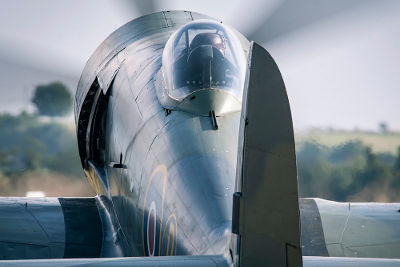 |
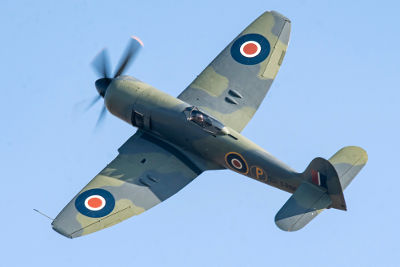 |
|
|
|
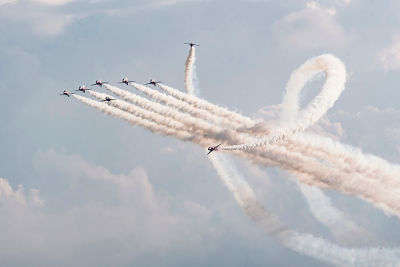 |
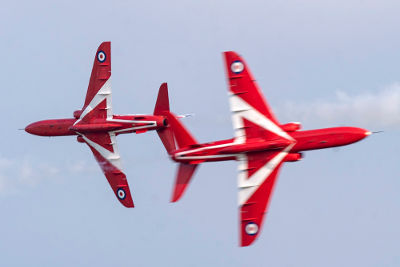 |
|
Today, we saw 14 Spitfires and 3 Hurricanes
in wing formation, filling the sky with machines and noise,
although the Red Arrows later slot restricted them to only one
pass in this formation. They departed to the west and then circled
in the distance to make another pass, this time in vics of three,
line astern, while the jester returned to entertain us. The wing
approached again, sunlight glinting, and half of the fighters
broke away, birds leaving the flock to return to their roost. As
Spitfires and Hurricanes drifted back to the earth in ones and
twos, the rest flew over us again before making their own break to
land leaving just a single Spitfire still airborne.
|
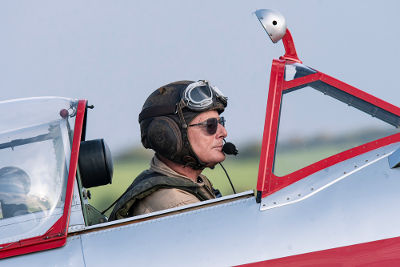 |
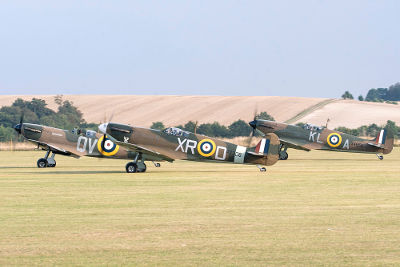 |
| This was Spitfire MkIXT
ML407, The Grace Spitfire, its pilot Pete Kynsey with one last
tribute to make. Carolyn Grace was a pioneer, owning, operating
and flying her Spitfire after the untimely death of her husband
Nick Grace in 1988. Carolyn was the only practising female
Spitfire pilot in the world but tragically lost her life in a car
accident in Australia in December 2022. Richard and Daisy Grace
continue their parents’ legacy through the Air Leasing Ltd at
Sywell. |
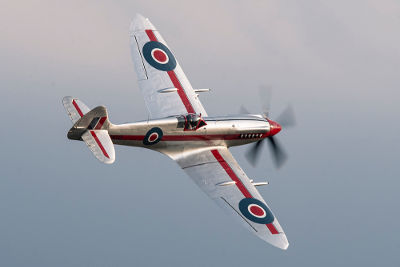 |
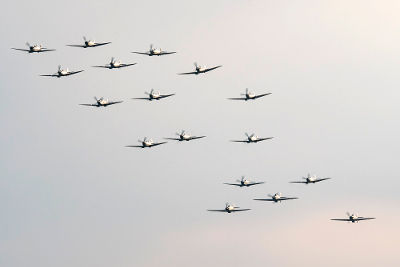 |
|
|
|
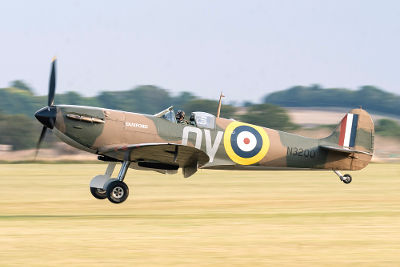 |
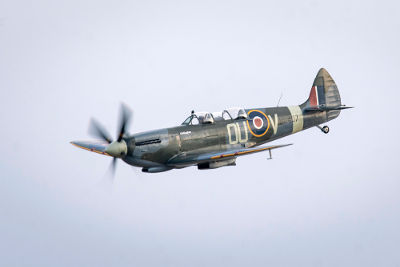 |
As the light from the late
summer sun turned to dusk, ML407 touched down to close what was an
extremely well organised and evocative airshow, aided in no small
part by the commentary of Aeroplane magazine editor Ben Dunnell
and broadcaster and historian Colin Wilsher. There is an always an
element of melancholy for the reviewer at this show with hay bales
in the fields and the light hinting at the oncoming glow of
autumn.
There was no chill in the air though, the Saturday
show enjoying temperatures in the mid 20s, although rain and cloud
did impact on the Sunday, but it still heralds the closing of
another season and another year with just a few events left to
look forward to before the aircraft are tucked away for winter
maintenance and TLC. If you haven’t visited this particular
Duxford airshow before then I strongly suggest keeping the weekend
free in your diary for next year! |
|
|
|
Review by Andrew Critchell
|
|
